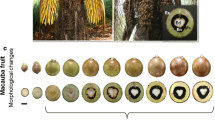Abstract
Chayote (Sechiumedule, Cucurbitaceae), a lesser-known member of the gourd family, is gaining in popularity and importance as a food crop worldwide. It is unique among cultivated cucurbits by bearing single-seeded fruits and exhibiting vivipary. Chayote, adaptable to a wide range of climatic conditions, can be grown with relative ease. In addition to its fruits, it yields tender shoots for use as vegetable greens, vines as ornament for fences or as animal fodder, and edible subterranean storage roots. It is worthy of being more widely used because it has good nutritional properties and a firm delectable fruit flesh texture and can be prepared in a variety of ways for consumption.
Chayote (Sechiumedule, Cucurbitaceae) ist einer der weniger bekannten Gattungen der Cucurbitaceae, obwohl sie immer mehr populaer und wichtig weltweit als Nahrungsmittel wird. Die Pflanze ist einzigartig unter kultivierten cucurbits wegen ihrer einsamigen Früchte und ausgeschossene Samen innerhalb einer Frucht (vivipary). Chayote, der sich zu abwechselnden Klimabedingungen anpassen kaun, lässt sich leicht anbauen. Zusätzlich zu der geernten Früchten kann man die weichen Triebe als Gemüse verwenden, sowie die Rebstöcke als Hofschmuch oder als Futtermittel verwerten. Ausserdem sind die unterirdischen Wurzeln, die kohlenhydraten speichern können, sind essbar. Die kultivation der Pflanze sollte aufgrund ihrer nahrhaften Bestandteile und ihres schmackhaften Fruchtfleisches, das vielfältig zum Verbrauch zubereitet werden kann, verbreitet werden.
Similar content being viewed by others
Literature Cited
Albone, K. S.,, P. Gaskin, J. MacMillan, and V. M. Sponsel. 1984. Identification and localization of gibberellins in maturing seeds of the cucurbitSechium edule, and a comparison between this cucurbit and the legumePhaseolus coccineus. Planta 162:560–565.
Aung, L. H., and G. J. Flick. 1976. Gibberellins induced seedless fruit of chayoteSechium edule Swartz. HortScience 11:460–462.
Ceccarelli, N., and R. Lorenzi. 1983. Gibberellin biosynthesis in endosperm and cotyledons ofSechium edule seeds. Phytochemistry 22:2203–2205.
Chopra, R. N., and R. C. Sacher. 1957. Effect of some growth substances on fruit development. Phytomorphology 7:387–397.
Clegg, K. M. 1956. The application of the anthrone reagent to the estimation of starch in cereals. J. Sci. Food Agric. 7:40–44.
Conrad, E. C., and J. K. Palmer. 1976. Rapid analysis of carbohydrates by high-pressure liquid chromatography. Food Technol. 1976 (Oct.):84-92.
Cook, O. F. 1901. The chayote: a tropical vegetable. U.S.D.A. Div. Bot. Bull. 28.
Flick, G. J., F. S. Burnette, L. H. Aung, R. L. Ory, and A. J. St. Angelo. 1978. Chemical composition and biochemical properties of mirlitons (Sechium edule) and purple, green, and white eggplants (Solarium melongena). J. Agric. Food Chem. 26:1000–1005.
Herklots, G. A. C. 1972. Vegetables in south-east Asia. Allen and Unwin, London.
Lorenzi, R., and N. Ceccarelli. 1983. Endogenous gibberellins in endosperms and cotyledons ofSechium edule during seed growth and maturation. Phytochemistry 22:2189–2191.
Lozoya, X. 1980. Mexican medicinal plants used for treatment of cardiovascular diseases. Amer. J. Chin. Med. 8:86–95.
Ogawa, Y. 1966. Acid, neutral and “water soluble” gibberellin-like substances occurring in developing seed ofSechium edule. Bot. Mag. (Tokyo) 79:1–6.
Purseglove, J. W. 1968. Tropical crops—dicotyledons. John Wiley, New York.
Sauer, C. O. 1963. Cultivated plants of South and Central America. Page 506in J. H. Steward, ed., Handbook of South American Indians. Vol. 6. Bur. Amer. Ethnol. Bull. 143.
Valverde, E., and M. V. Saenz. 1985. Analysis del crecimiento del chayote (Sechium edule Sw.). Turrialba 35:395–402.
Watt, J. M. 1962. The medicinal and poisonous plants of southern and eastern Africa. 2nd ed. E. & S. Livingston, Edinburgh.
Whitaker, T. W., and G. N. Davis. 1962. Cucurbits. Interscience Publishers, New York.
Author information
Authors and Affiliations
Rights and permissions
About this article
Cite this article
Aung, L.H., Ball, A. & Kushad, M. Developmental and nutritional aspects of chayote (Sechium edule, Cucurbitaceae). Econ Bot 44, 157–164 (1990). https://doi.org/10.1007/BF02860483
Received:
Accepted:
Issue Date:
DOI: https://doi.org/10.1007/BF02860483




